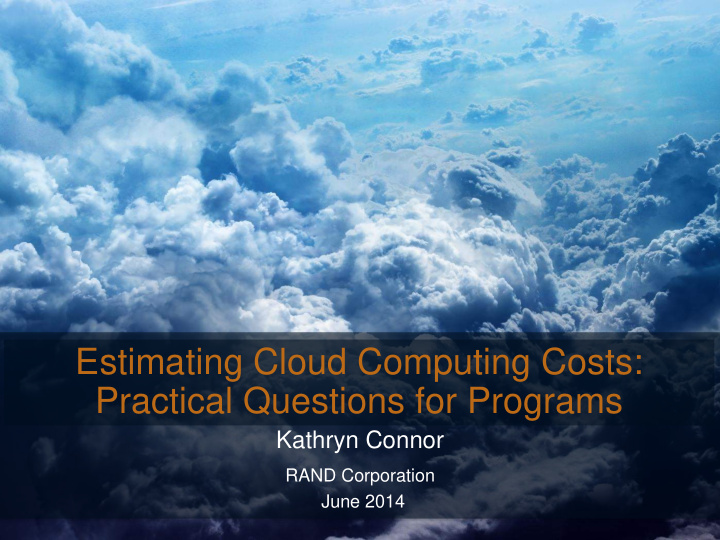



Estimating Cloud Computing Costs: Practical Questions for Programs Kathryn Connor RAND Corporation June 2014
In 2010, the OMB proposed Federal Agencies consolidate data centers to save money. In 2013, the plan shifted focus to data center optimization.
GAO found agencies are reducing their footprint through consolidation…
…but the OMB cannot assess whether savings were actualized.
Central tension: Programs with large data center demands want to exploit new trends in data storage and processing, yet have trouble demonstrating their cost effectiveness.
In 2011, the Federal CIO publishes a cloud strategy, followed by the DOD CIO in 2012, proposing the shift of core data centers to the cloud.
Cloud solutions are seen as ready-made cost savings, but may not suit security and computing needs. Programs split across enterprise managed and commercial cloud resources becomes a real option.
Total life cycle costs vary greatly by commercial provider, one notional system cost twice as much with provider 2. 100% 55%
Difference is even starker for notional facilities and service level agreement costs. 100% 15%
How does a program understand whether cloud is cost effective for them? To understand the current state of policy and cost we have consulted: Literature • Including and Policy on prior ICEAA briefs Cloud • Providers Data centers and Users Commercial • Available cloud pricing to the public structures
Estimating cloud computing costs is difficult with the limited analogies available in the public sector
There are a few possible analogous systems, but real data on RDTE, Procurement, and particularly O&M are scarce. • Distributed Common Ground System- Army – Created portable cargo container sized clouds • NAVSEA is developing a relationship with Amazon Web Services, that program inside the Navy and other services can leverage for a fee. • Distributed Common Ground System- Navy (DCGS- N) and Military tactical Command and Control (MTC2) have been working on cloud computing • Intel community has developed several cloud based systems
Military programs are new to the cloud, and cloud vendors are new to government acquisition. Crossing boundaries requires careful attention.
Few policies or resources directly address cost estimators, so we developed a structure for understanding cloud cost drivers
Divide potential cost impacts into 5 common categories of military estimates software personnel hardware security data 101000 101011 011010
“Reused” code may mean legacy systems that cannot be changed; “New” touches old and future systems Does the future or existing rely on a New/ specific OS, and does it mesh with Existing cloud system requirements? Will the license costs be New/ Existing sustainable? What is the impact of a shift to open source? Do current assets function in Existing virtualized and or cloud environments? Are they efficient? 16
Upgrade path of the cloud provider can impact government investment requirements How often do you upgrade? What are the cost implications if our software cannot be updated on that schedule? What licenses does the cloud provider include? What future updates/ changes is the cloud provider planning for? 17
Capacity pricing varies by vendor, so adjust modeling accordingly What are the assumptions about hardware utilization? What are the best and worst case scenarios for resource requirement growth? How are the virtual machines sized in the vendor’s pricing structure? 18
Potential hardware issues extend beyond the servers to communications and system recovery What communications lines are the responsibility of the contractor vs the government? Is the program willing to forgo a backup system because of cloud capability? Does the vendor have facilities in enough areas for continuity of operations? 19
Contracting for substantial cloud capabilities shifts, but does not eliminate , personnel requirements What system administrator tasks would remain with the government? How will the logistics and contracting staff change if the program does not purchase hardware? If the cloud mitigates the requirement for secondary continuity of operations capacity, how does that impact staffing? 20
Clouding computing is least expensive when the system does not need sensitive data What portion if any of the data will be classified? Will there be transfers of data from classified networks to unclassified networks? Can commercial providers meet data safeguarding standards? When do they anticipate meeting DIACAP requirements? Do they currently have classified data customers? Can they handle classified data? 21
Security with commercial cloud provider comes at a price, but with sufficient demand prices should drop. Is resource pooling ok for all or just part of the data and software? Will there be enough other customers requiring similar levels of security for peak load economies of scale to kick in? Does the provider offer effective VM isolation and data protection? Does the provider offer server management by U.S. citizens only? 22
Split programs may mean splitting where data both reside and are processed How much of the system will be on the cloud? Are there any portions that will be more efficient outside of the cloud? Is there existing data that will need to be migrated? How will the structure of this data need to change for it to operate efficiently in a cloud environment? 23
How the notional cost drivers roll up Cost Driver Direction of Cost Operating system (Linux) Increased frequency of software update Licenses provided by cloud provider System utilization best described as peaks and valleys (not flat demand) Classified data will be required by system Data will be transferred from systems at one classification level to another Creation of a private cloud or adding layers of data protection / System administration by US Citizens only Provider has many customers with similar needs Data migration from a SQL to distributed database format
Recommend
More recommend